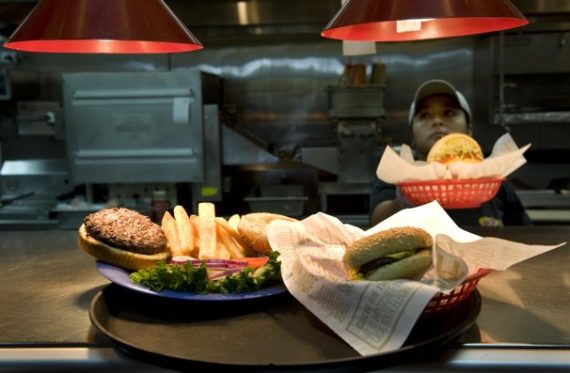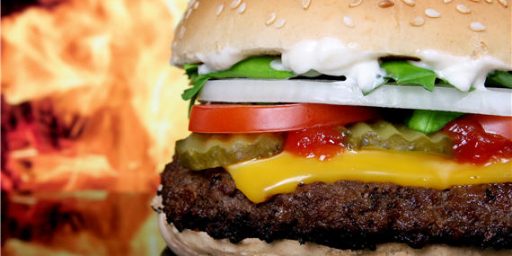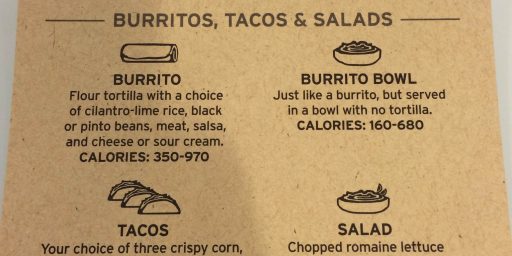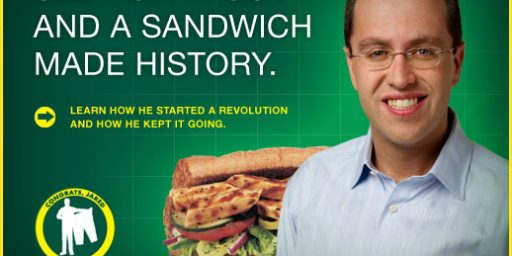Putting Calorie Counts On Restaurant Menus Doesn’t Accomplish Anything
Not surprisingly, people still order that big juicy cheeseburger even after being told it contains over 1,000 calories.
Requirements that restaurants put calorie counts on their menus have been a favorite policy of health advocates on the left for years now. Some cities, such as New York City, have already adopted them in limited scope, and the Affordable Care Act contains a requirement that restaurant chains beyond a certain size provide calorie information on their menus. On it’s face it seems like a logical idea – give people information about the calorie and fat content of the Double Whopper With Cheese they’re about to order and people will start to think twice, and hopefully order something healthier. As it turns out, the evidence available from jurisdictions that have adopted nutritional labeling requirements shows that they have very little impact on consumer food choices when dining out:
Evidence is mounting that calorie labels — promoted by some nutritionists and the restaurant industry to help stem the obesity crisis — do not steer most people to lower-calorie foods. Eating habits rarely change, according to several studies. Perversely, some diners see the labels yet consume more calories than usual. People who use the labels often don’t need to. (Meaning: They are thin.)
Questions about the effectiveness of calorie disclosure come as the federal government is finalizing regulations to nationalize labeling in chain restaurants next year as part of a measure tucked into President Obama’s health-care law. Some chain restaurants are tweaking menus in anticipation, offering more low-calorie meals. Yet several high-cal eateries that operate in Montgomery — including the Cheesecake Factory, Chipotle, Five Guys and Red Robin Gourmet Burgers — report no change in dining habits because of the labels.
“Have we seen a big [drop] in sales? No, not at all,” said Todd Stallings, owner of several Five Guys restaurants in Montgomery, which based its rules on the upcoming federal policy. “When people come to Five Guys, they know we are not cooking their french fries in water.”
Some experts question the wisdom of the labeling policies, even if they agree that people have a right to know the caloric content of what they are ingesting. (Recommended daily calorie intake varies based on age, weight, height and activity levels but is generally 2,500 for men and 2,000 for women.)
“There is a great concern among many of the people who study calorie labeling that the policy has moved way beyond the science and that it would be beneficial to slow down,” said George Loewenstein, a behavioral economist at Carnegie Mellon University who studies calorie labeling. In a recent editorial in the American Journal of Clinical Nutrition, he asked: “Given the lack of evidence that calorie posting reduces calorie intake, why is the enthusiasm for the policy so pervasive?”
Not only that, but the evidence available from jurisdictions where menu labeling laws have been in effect shows that they clearly don’t impact human behavior
In New York, the first big city to adopt menu labeling, NYU researchers studied the eating choices of low-income fast-food diners, focusing on
those who saw the labels. “Even those who indicated that the calorie information influenced their food choices did not actually purchase fewer calories,” the study says.Research in a fast-food restaurant in King County, Wash., where calorie labeling is also law, found similar results. The stated finding was grim: “Mandatory menu labeling did not promote healthier food-purchasing behavior.”
Another recent study shows what really worked was imposing a higher price — by way of a tax — on big-calorie items.
Loewenstein, in his editorial, cited just one “rigorous” study showing a positive effect: at Starbucks stores in New York City, where diners seeing calorie information reduced their intake — but only for food, not beverages. Researchers consider that result a bit of an outlier, theorizing that Starbucks consumers are more sensitive to nutritional information. “I’m sure the average BMI at Cheesecake Factory or McDonald’s is a lot larger than at Starbucks,” Loewenstein said, only half-joking.
Experts say that for most diners, the issue is not about having information but about lacking self-control. Behavioral economists have for years zeroed in on a logical hiccup: We are unable to balance short-term gains with long-term costs. Many humans are simply really, really impatient. With eating out, the gains are immediate (yummy giant burrito!) and the costs are delayed (staggering bills for heart disease!).
“The long-term consequences are totally intangible,” Loewenstein said. “Eating has that in common with cigarettes: One cigarette is not going to kill you, and one big meal is not going to kill you. But the difference is, you need to eat to survive. So there’s an easy rule for the cigarette problem: Stop. There is no easy rule for eating. We must eat.”
Not only must we eat, but generally we like to eat things that taste good, and the stuff that tastes good is often high in calories, fat, and cholesterol. We are, in other words, human and not robots who will simply process a number on a menu and decide oh I’ll have the salad instead. And, quite honestly, when you’ve already made the choice to go to a place like McDonalds, or Five Guys, or The Cheesecake Factory, healthy eating isn’t really at the top of your list of priorities at that moment in time. It’s not just menu labeling that doesn’t seem to have an impact on human behavior. A recent study concluded that taxes on sugary sodas won’t cause overweight people to drink less sugary soda, because by and large they already drink diet sodas.
Steven Chapman looked at the folly of menu labeling laws in a Reason article back in 2009:
[T]he early evidence suggests that people don’t choose high-calorie fast foods because they don’t know any better. They choose them because they like them, and they don’t really care if othersAdam disapprove.
That’s the implication of a new study in the journal Health Affairs conducted by researchers at New York University and Yale University. They asked questions of and collected receipts from customers at McDonald’s, Burger King, Wendy’s, and KFC outlets in the city before and after the law took effect, and did the same in Newark, N.J., which has no such law.
The impact of the ordinance didn’t quite fulfill those fond expectations. To start with, only about half of the fast-food customers in New York said they noticed all this helpful information, and only a quarter of the patrons in this group said it made any difference in their choices.
Even those who said the data affected their decisions were fooling themselves. Before the law was implemented, the average customer in New York bought items containing 825 calories. Afterward, the figure was 846. In Newark, during the same time period, the typical patron went from 823 calories to 826.
In neither place did diners cut back on saturated fat, sodium, or sugar. The labeling law was the moral equivalent of the Chicago Olympics bid—lots of hype to little effect.
Despite clear evidence that the laws don’t achieve their intended effect, Matthew Yglesias seems confused why anyone would oppose them:
Enthusiasm for the policy is so pervasive because the intervention is so utterly mild. Compare that to a proposal for a $100 tax on cheeseburgers. A cheeseburger tax would be extremely burdensome on people who really like cheeseburgers. It’s possible that you could persuade me that the public health benefits would be so dramatic that this kind of seemingly arbitrary tax is a good idea, but that’d be a high evidentiary hill to climb. But the long-term financial cost of making people print calorie counts on menus is zero. It’s possible that consumers turn out not to care, in which case there’s no cost at all. Alternatively, if it does turn out that some firms’ interests are adversely impacted by the rule that would have to be because it turns out that consumers actually do care a lot about calorie counts. At worst, there’s no impact. At best, you’re helping people. Either way, it seems worth doing.
Adam Serwer makes the same “low cost, more information” argument:
As The Washington Post story suggests, for that reason it doesn’t hurt businesses’ bottom line either. But if the calorie labeling doesn’t meaningfully improve public health, it at least provides the consumer with the data to make an informed decision. With labeling, it’s harder to argue that your weight problem is someone else’s fault, whereas nannyism seeks to prevent you from making your own choices — by say, banning Happy Meals. Informed consent is a worthy goal in and of itself, even if people still choose to eat poorly.
When you’re talking about large chain restaurants, it’s likely true that a menu labeling law doesn’t significantly increase the cost of doing business, or at least not to a degree that impacts the bottom line. These are large corporations, or the very least franchises supported by large corporations, and menu redesigns are a routine part of business. Adding in some information about nutritional content wouldn’t be difficult at all. In fact, some restaurant chains already provide information of that type on their menus because they’ve used it as a way to appeal to people who are on weight management programs like Weight Watchers. The same can’t said, though, of smaller restaurants, which may consist of merely a single restaurant or a small chain, as this interview with the owner of Davanni’s, a chain of 21 pizza/Italian restaurants in the Minneapolis/St Paul area points out:
Ed Morrissey, who conducted the interview in the wake of the discovery that the Affordable Care Act included a menu labeling mandate, made this point:
The pressure of this law will eventually force restaurants like Davanni’s to reduce consumer choice as a way of managing the overwhelming burden of maintaining their disclosures. Smaller chains that succeed in satisfying their customers and managing their business used to be rewarded with growth, but this law will put an artificial cap on expansion at 19 locations. That means that fewer people will find jobs, and even in existing stores, money that may have funded more jobs will instead go to reprinting the same menu boards over and over again. And all of this comes because political elites think that people are too stupid to know that a pizza is fattening or how to access information that already exists in much more efficient formats than menu boards.
There are already several sources out there where you can find out the nutritional content of the food served in most large chain restaurants, why people like Yglesias and Serwer think that mandating that this information be included on every restaurant menu when it’s shown it doesn’t really change behavior is extremely puzzling.
There are other problems with these laws, of course. For example, who determines what the “correct” calorie count is for a given dish. A prepared meal isn’t like a pre-packaged meal in a supermarket whose nutritional information has already been determined. Sometimes, a chef will make changes to a dish on a daily basis that would make the information set forth on a menu incomplete. Who gets to say what an acceptable deviation would be?
As with other such regulations, a menu labeling law will inevitably hurt smaller businesses far more than it hurts large ones. As I noted above, the costs of adding nutritional information to a menu is relatively small for a large chain. That’s why you don’t hear the McDonald’s of the world objecting to labeling laws, they know they can comply with them at minimal cost. It’s their competitors in the smaller restaurants who will bear the brunt of the costs of the regulation, and who are also more likely to be the subject of disciplinary action by regulators for non-compliance with some hyper-technical aspect of the law. If you’re okay with hurting small business at the expense of big business I suppose it doesn’t matter to you, but when you combine this with the fact that it has no real impact on human behavior it seems pretty clear that these laws are a big waste of time.
Photo via The Washington Post






Does anybody have the slightest idea why Matt would write this?
Hey, how about labels on newspaper columns informing readers the columnist is an idiot? just look at the related link ‘It’s got cheesecake right in the name’ for an episode where young and dumb Ezra Klein is surprised to find carbonara is high calorie. He apparently couldn’t recognize the cheese, bacon, eggs and, sometimes cream, in the dish.
The only time people are surprised about the calorie content is when they are eating some supposedly healthy alternative such as salads, which by the time they are tasty are high calorie.
And can someone please explain how bread, tomato sauce, cheese and a few assorted toppings becomes fattening when made into a pizza but not when eaten as discreet items? Same for ground beef, a roll, lettuce, tomato and perhaps some cheese, bad as a hamburger but okay as a blue plate special? But I still laugh when the ‘elites’ pay extra for polenta but turn their noses up to grits. Or go on and on about pancetta but deplore people eating bacon.
@PD Shaw:
Because in Matt’s world, menus and recipes never change and printing is costless. See the WP doesn’t charge him a penny to print his mindless thoughts they just magically appear with not cost to anyone.
This is such a silly post. My wife was studying the calorie counts on a menu just last week, diligently seeking a lower-calorie entree.
The fact that some people don’t give a whoop is no reason to withhold information from those who do. I don’t understand the hostility to giving people the information to make good choices if they are so inclined.
The only time people are surprised about the calorie content is when they are eating some supposedly healthy alternative such as salads, which by the time they are tasty are high calorie.
I don’t know. It seemed illuminating to me when a town I lived in started doing it. For instance, you might look at a McDonald’s Big Mac and think “a lot of calories” and a Jack in the Box All-American and think “a lot of calories” without realizing that the difference between the two is very significant.
I’m willing to accept that I am an outlier who actually acted on this information. But it was nonetheless helpful to me.
In New York, non-chain restaurants are exempt from the law. So smaller businesses aren’t hurt.
I take my kids to McDs sometimes. I definitely switched from my usual Angus Burger to Grilled Chicken once I understood how much difference there was. I knew the chicken was healthier, but didn’t realize the degree. At least reasonable approximations are helpful. It can also be nice that these requirements can inspire restaurants to try to make more sensible health choices, such as lite sour cream and so forth. When they don’t have to disclose, they make choices only to maximize taste or cost. I’m sympathetic to arguments against unnecessary regulation or overly precise or inflexible rules, but I’d like to see more info at restaurants. So long as it doesn’t turn into a 17-page disclosure about my privacy and e-coli odds and so forth like the government forces others to send in the name of disclosure, like credit card or cable companies, and then the disclosure goes straight into the trash because no one has time for it.
Yes, why should we inconvenience businesses to the point that they actually have to tell us what they’re selling us?
Calorie menus have helpd me tremendously. To keep my weight up in a healthy range I have to ensure I eat the worst possible crap, the biggest hamburger and the most fattening sandwich. There is, however, some small possiblility that being good for me personally may not justify the program.
By the way, this post story looks heavily derived from a March article in the USDA’s Amber Wave publication. Another lazy journalist?
http://www.ers.usda.gov/AmberWaves/March11/Features/CalorieLabeling.htm
Is that what Matt is getting at? Personally, since I rarely go to a chain restaurant; there are not any AFAIK in my city’s downtown except Starbucks, such a law would have virtually zero costs, as well as zero benefits. Rock on.
I use the labels all the time.
Sorry to agree with so much comment agreement, but I do check, and I do act accordingly. If I’m doing a Wendy’s drive-thru the 250 or so calorie difference between a Chicken sandwich and a double with cheese often tips the balance for me.
I find myself using the labels when I eat out, but then I’m weird. Granted, if you’re not actively trying to watch what you eat the labels are largely pointless but for me, having even a rough estimate of the calories I’m eating at a given meal helps determine what my total intake is each day. Also, a lot of seemingly healthy, innocuous items like salads and vegetable wraps can pack big caloric punches because of dressings and so forth. I figure the more information, the better.
I don’t have a problem with this law when it comes to large companies that can drop the hundreds of thousands of dollars to get all of their foods lab tested for calorie counts. But if it comes down to mom + pop places having to drop 5 figures to send all of their menu items to labs to comply with this law, then it becomes unreasonable. Also, doesn’t this kind of law completely kill the idea of a daily special at restaurants? No restaurant is gonna take the time to drop a huge amount of money to test a one-off dish that they might never serve again. And it also kills any sort of improvisation by the chef.
@Ben: I would expect that more often than not, the ingredients they get are going to have nutritional information available, no? I calculate health content for things I make all the time. The calculations don’t have to be (and can’t be) exact, when finding the exact amount would prove to be a hardship.The nutritional info for most chains – where it would not be a hardship – are available online.
@Trumwill:
I don’t know about you, but every time I’ve ever been in the kitchen of a restaurant (particularly the mom & pop kind), they are much less diligent that you or I are about measuring out or weighing portions and using pre-determined amounts of ingredients. They just slather a chunk of lard/grease/butter whatever on the cooking surface, grab handfuls of whatever and throw it on, and just throw toppings on. It’s all very unscientific and inexact. I imagine that these laws have some sort of requirement for being accurate within a range, and I bet you 90% of these places couldn’t even ballpark the caloric content within 25%.
“Enthusiasm for the policy is so pervasive because the intervention is so utterly mild. Compare that to a proposal for a $100 tax on cheeseburgers. ”
Is Matt Yglesias REALLY trying to assert that there is a taxing entity anywhere in the world that levies taxes at rates exceeding 2000%? And does he know what an ad absurdum argument is? I see his point that the policy is pretty innocuous and probably doesn’t even raise operating costs for the restaurants in question. But to compare the regulation to a tax that no legislature in its right mind would levy (including cities in California where it can be argued that legislatures AREN”T in their right minds in general) does not add any real meaning.
Of course, it’s also possible that he knows that he’s supporting a big handful of air and wants to make the case seem more important.
@PD Shaw: Because one of the objections of businesses in King County (where I am from) was that calling for restaurants to list calorie counts on menus would raise the costs of menu production prohibitively and that the law was actually intended to drive Mickey D’s and other franchises out of business.
In other words: it responds to typical libertarian cannards about regulations.
No it’s not. Its more information for consumers to factor into their purchasing decisions. Forcing large chain restaurants to include caloric (and Fat, Sodium, Protein, et. al.) content on their menus helps the market for prepared foods become more efficient.
If you’re opposed to this kind of basic disclosure regulation, then you have a fundamental misunderstanding of how capitalism is supposed to work. Efficient markets require information, and that more information for consumers increases allocative efficiency.
I’ve used the info, both to choose my meal and to adjust odds of a return visit.
I suspect there are all kinds of things this study cannot show. After learning how big lunch really was, how many had a light dinner?
Just download the LoseIt app – a friend of mine has lost 37 pounds using that thing!
I think objections to this idea are way overblown. It is not hard to tote up the nutriitonal information for a recipe using a web resource like caloriecount.com.
Saying that experience shows that people don’t pick the salad over the burger when given the calorie information is irrelevant because you are comparing apples and oranges. The relevant choice is between two burgers, with one having 200 calories more than another. For many people, there will be no difference in satisfaction between the two offerings, and when given the choice a lot of them will pick the lower calories.
It is perfectly possible for you to engineer many foods to make them lower calorie without affecting taste. My wife and I have done this with our dishes at home over the last year, have collectively lost 200 lbs and now are both at healthy BMIs. An example of enginnering: a use low-carb tortilla instead of a regular wrap for your sandwiches. You can save 200 calories for free. Yet you cannot know what sort of wrap the restaurant is serving you if you are denied the nutrition information that would tell you.
Salt is worse. WIth calories you can usually ballpark as to what you are being served but you cannot know how much sodium may have been placed in your food. The idea that you have to have lots of salt or fat to taste good is bullshit. You can find this out for youself by checking the labels in the store and trying ingedients with different levels of salt, fat, calories etc and using spices and other substitutes creatively.. For a given person many subsititutions will work fine, some won’t.
Without labeling there is no incentive for restaurants to experiment since if they come up with a healthier version of a dish it will compete against a competitor’s product that will be perceived as being the same, even though its probably not (but you can’t prove it). If the restaurants have to provide nutirional info, then they can compare their product directly with their competitors and can gain customers whofind they can enjoy this food again–but only at this particular restaurant.
I’ve recently lost over 35 pounds on a calorie counting diet. A law in Seattle requiring menu labeling helped me to do this. In fact, I often chose to go to the chain restaurants with the labels instead of the small mom-and-pop joints that were not required to label menus. I think that the impact of labeling menus with calories should be studied again, perhaps over a longer period of time. How was the study conducted? Who conducted it?
Also, the author of this post should really re-consider the argument that since the affordable care act requirements starts at 20 restaurants that a thriving business would stop growing at 19. If you were a very successful business you would just figure out how to deal with the requirement and continue growing.
lol, just re-read and noticed this line:
Maybe they are thin because they were making calorie guesses, and this saves the guesswork? Hhahaha. Darn thin people.